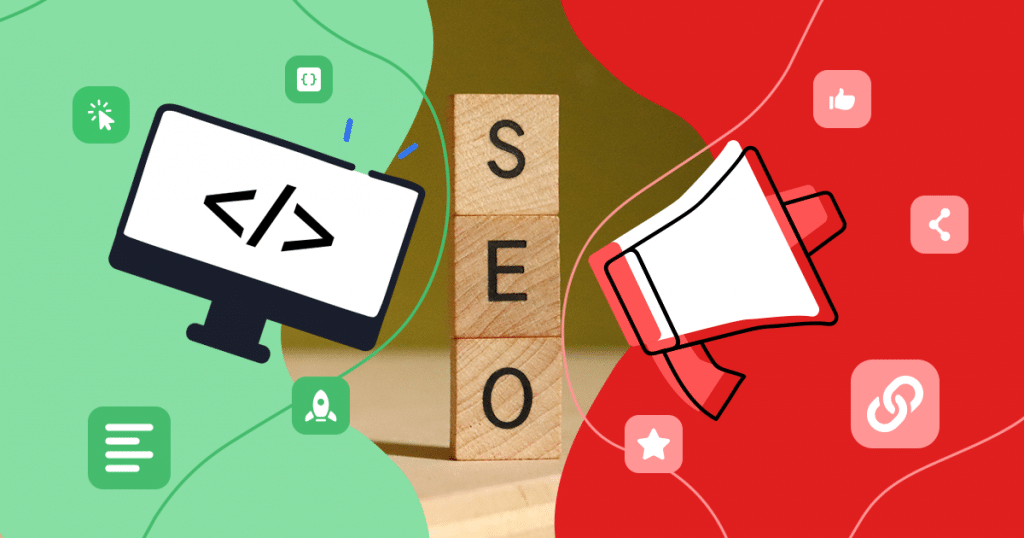When you want to increase your page ranking on Google or other search engines, search engine optimization (SEO) is key.
There are two different categories of SEO: on-page and off-page. Both of these play an important role in the success of your overall marketing campaign.
Keep reading to learn the difference between on-page vs off-page SEO as well as the features of each, which will help you up your SEO game.
What is On-Page SEO?
On-page search engine optimization refers to the optimization of the pages that are on your website, including the content as well as the backend.
The ultimate goal of on-page SEO is to improve web pages on their own to rank as high in the search engines as possible by driving organic, qualified, and targeted traffic to the website.
It offers control over a variety of factors that can have an impact on your ranking.
The location of where your website appears in the SERPs will be determined by a number of ranking factors or features, including title tags, keywords, page speed, site accessibility, etc.
These are all things you can control and change on your website.
On-Page SEO Features
Let’s take a look at some of the main features you need to know.
Title Tags
The title tag is designed to inform search engines and visitors of what a specific page is about. It also helps to establish proper relevance.
Title tags are among the most important on-page SEO factors. Because of this, you want to ensure that your targeted keyword for that page is within the title tag.
Ultimately, your title tag should be limited to 60 characters — and this does include spaces.
The keyword should be as close to the front of the title as possible, but you should never stuff keywords or place them unnaturally.
URL Structure
Google is all about user-friendliness, which is something to keep in mind as you are building your URLs.
Your URL should always have your main keyword in it, but the keyword shouldn’t be repeated. It should only appear once in the URL; otherwise, the user experience can be negatively impacted.
URLs should also be kept as short as possible so as to not confuse visitors and to make it easier to remember.
Heading Tags
The user experience is an important part of building your website, and this includes the use of heading tags.
One of the very first elements that visitors will notice on your website is the H1 tag, which is the headline or heading.
Headings are designed to assure visitors that they’ve landed in the right place and found what they’re looking for.
Of course, if you are practicing clickbait, then the above doesn’t apply. Clickbait is designed to drive clicks and nothing more.
Working to optimize your page’s H1 tags for targeted search intent and queries will increase the chance of your page becoming a featured snippet at the top of the SERPs.
You should only have one H1 title tag per page, with the rest of your headings ideally being H2 and H3, although you can go beyond that if necessary.
Search engines will put the most weight on your headings than the rest of the content on the page.
Internal Text Links
Internal links lead to other pages of your website. This is useful for search engines and visitors.
For some context, internal links should always have a relevant anchor text, which is the text that you click on to take you to another internal page.
“Internal links” is hyperlinked at the beginning of this section and will take you to one of our blog posts that offers more information about internal linking.
Since the blog post is specifically about internal links, this text is relevant as anchor text.
Linking internally to other pages on your website is a quick and effective way to boost your content and gain better SEO results.
Alt Text for Images
Some people have never heard of alt text, but it is an additional identifier for your images.
This alt text is only visible to you in the backend of your system and to Google. You never have to worry about visitors seeing this text.
The alt text should always accurately describe the image, which aids search engines in understanding the content of your page.
When creating the alt text, use 8 to 10 words, include your target keyword, and include a geo-location, if relevant.
Page Load Speed
Since 2010, site speed has been an official ranking factor for Google.
The reason this is so important is because the user experience is dead when pages don’t load quickly, not to mention the fact that a slow website will have a direct and negative impact on your SEO and impact your bottom line.
Studies show that approximately 40% of individuals will leave a website if it takes longer than three seconds to load.
Therefore, as each second passes and your site is still loading, the closer you are to high abandonment rates.
Google offers a special tool known as PageSpeed Insights that can help you in the analysis of your site, both desktop and mobile. This tool even offers tips on how you can optimize your page load speed.
When something is weighing down your website, there are a few things you can consider.
For instance, you will want to keep your server response time below 200ms, images under 100kb, and browser caching is set to a minimum of one week.
Further, you can minimize HTTP requests, place CSS in an external sheet, and prioritize loading of content above the fold.
What is Off-Page SEO?
Off-page SEO refers to the steps that are taken outside of the website that influence search engine rankings.
You don’t have as much control over these as you do on-page SEO features.
This type of optimization ultimately takes a look at how popular and authoritative your website is.
Most people think of link building when they hear the term off-page SEO, but there are many other factors that play a role in your website’s ranking, including website design, social media engagement, and brand mentions.
Off-Page SEO Features
Here are the most important features you need to know.
Link Building
When other websites link to your website, it is considered a vote of confidence.
The more votes you receive, the more likely it is that you will rank high on search engines.
The opposite is true as well. The fewer votes you receive, the harder it will be to get your site into the SERPs, as Google doesn’t view you as authoritative and trustworthy.
Ultimately, you need other websites to vouch for you, which is where backlinks come in. Creating external links is an important part of your overall strategy.
There are many ways in which you can build links for your website, such as writing guest posts, contacting relevant and trustworthy sites to see if they would be willing to link to your content, and creating press releases and other content that can be submitted to article directories.
Keep in mind that Google does pay attention to the quality of these backlinks and not just the number of them. The site that is linking back to yours needs to be an authoritative site.
Social Media
Many people assume that social media has incredible SEO benefits. However, Google does not take into account your social media presence when ranking your site.
While that may be true, it doesn’t mean you should forget about social media. In fact, there are indirect SEO benefits that social media can offer.
For instance, social media can improve brand awareness, build an audience specifically for your website, and increase the number of brand mentions and inbound links from your online presence.
Aside from helping to reach a wider audience and drive revenue, social media has the potential to help your content go viral.
When this happens, there will be natural and organic links back to your website that mention your brand.
Brand Mentions
A great way to build more links is to locate brand mentions that are unlinked.
It can be particularly helpful for new websites that are trying to get those first 50 to 100 backlinks.
The easiest and most effective way to monitor mentions of your brand is using a third-party tool.
As soon as you have uncovered websites that mention your brand, you can send them an email and politely request they add a link to the brand mention.
In doing so, you can get brand-new backlinks while also gaining referral traffic.
Content Marketing
Content marketing has the potential to help you reach a much wider audience than before and provide them with incredibly valuable information that addresses their individual needs and wants.
Aside from the content that you are publishing on your website, such as blog posts, you can also take advantage of alternative methods like surveys, guest blogging, and downloadable reports.
These can help drive traffic and generate leads while also improving your ranking in the SERPs.
On-Page vs Off-Page SEO: Which Is More Important?
Despite what you may believe, both on-page SEO and off-page SEO are important — equally important.
In order to obtain high rankings on search engines, both of these are necessary.
In certain instances, you may want to place more of your focus on one rather than the other, but this never means that you should discount the other.
They work in conjunction with one another to bring your website to life in the search engines.
Wrap Up
Simply speaking, you cannot have on-page SEO without off-page SEO, as they work together to provide search engines like Google with a full and clear picture of your brand’s website.
In addition, you cannot set up SEO and leave it. It is something that you have to continually work on in order to realize the benefits.
Ready to learn more about SEO? Stay on top of the latest SEO trends!

![[WA] Ultimate Content Marketing Kit](https://rockcontent.com/wp-content/uploads/2022/08/Content-Marketing-Kit-750x200px.jpg)


![[ROCK NA] [EBOOK SEO] Complete Guide](https://rockcontent.com/wp-content/uploads/2024/06/banner_Search-Engine-Optimization.png)






